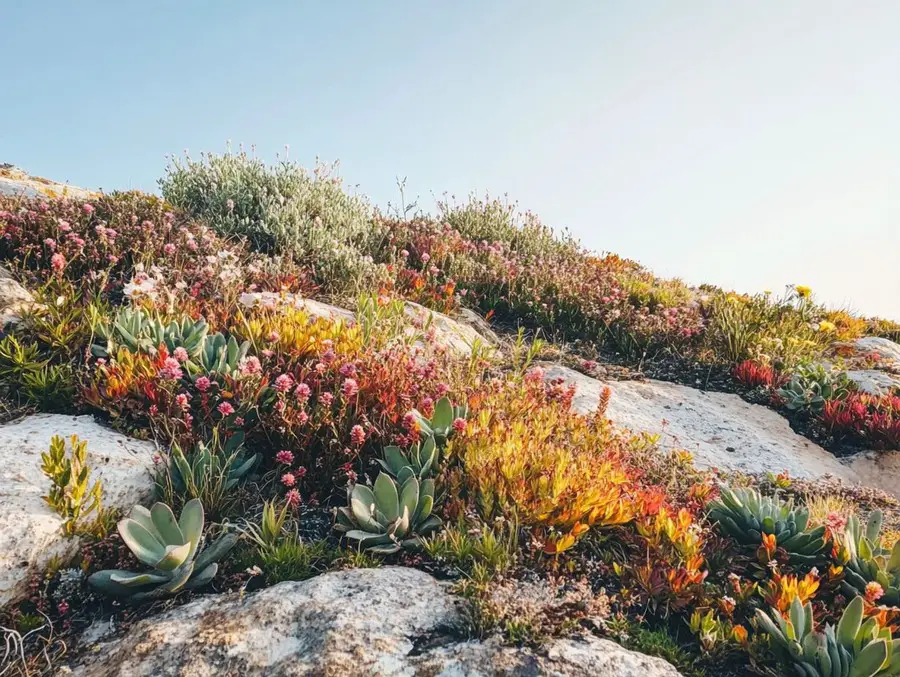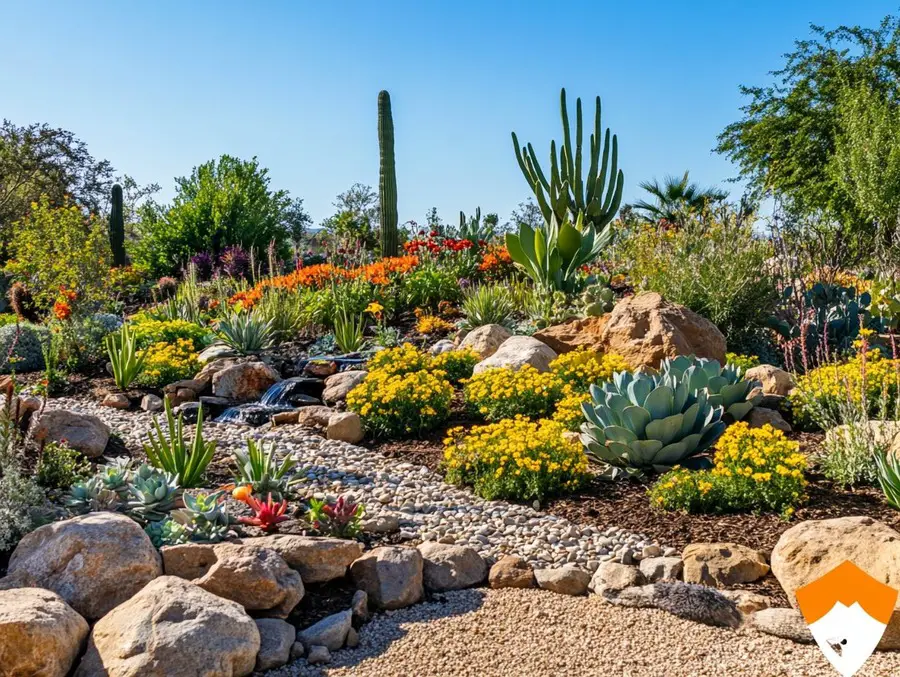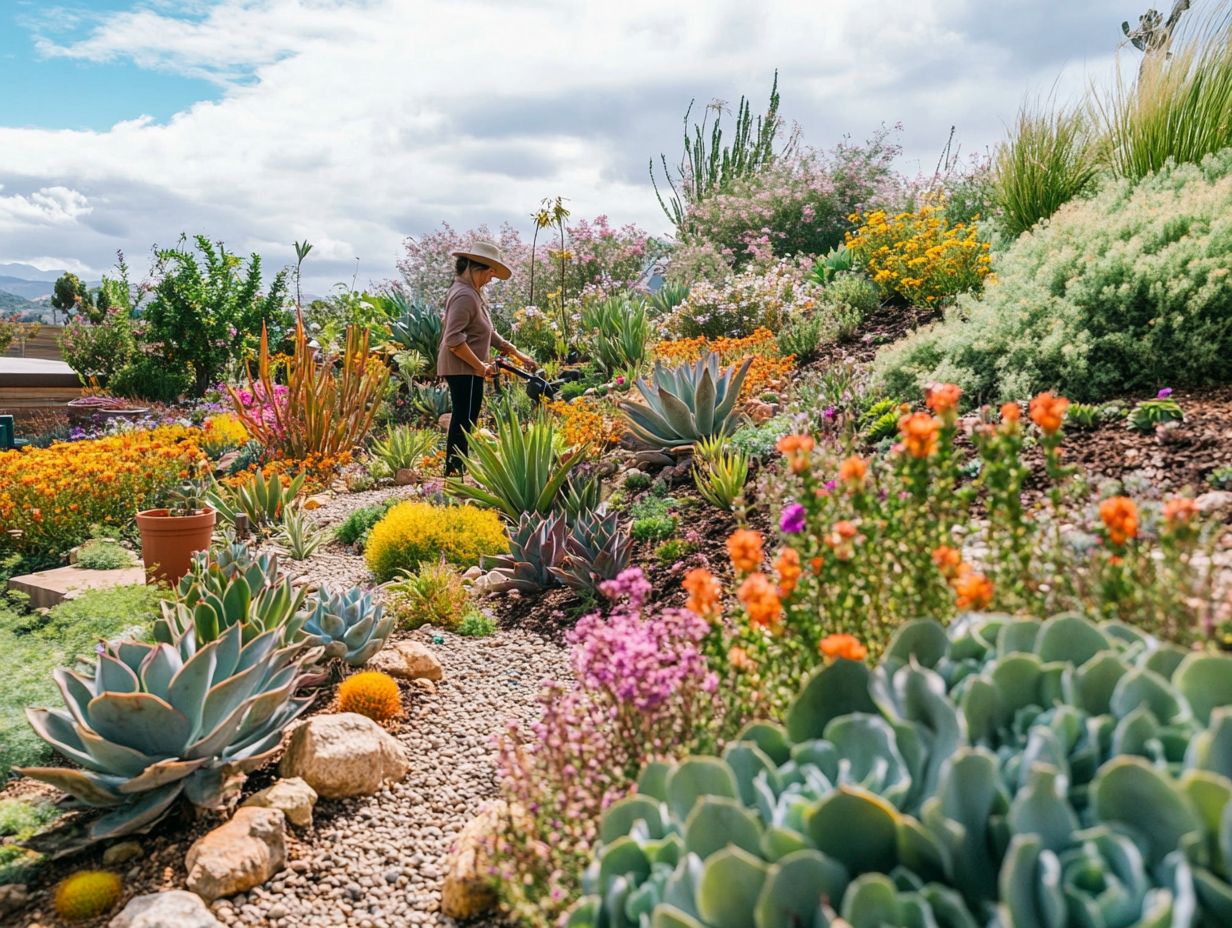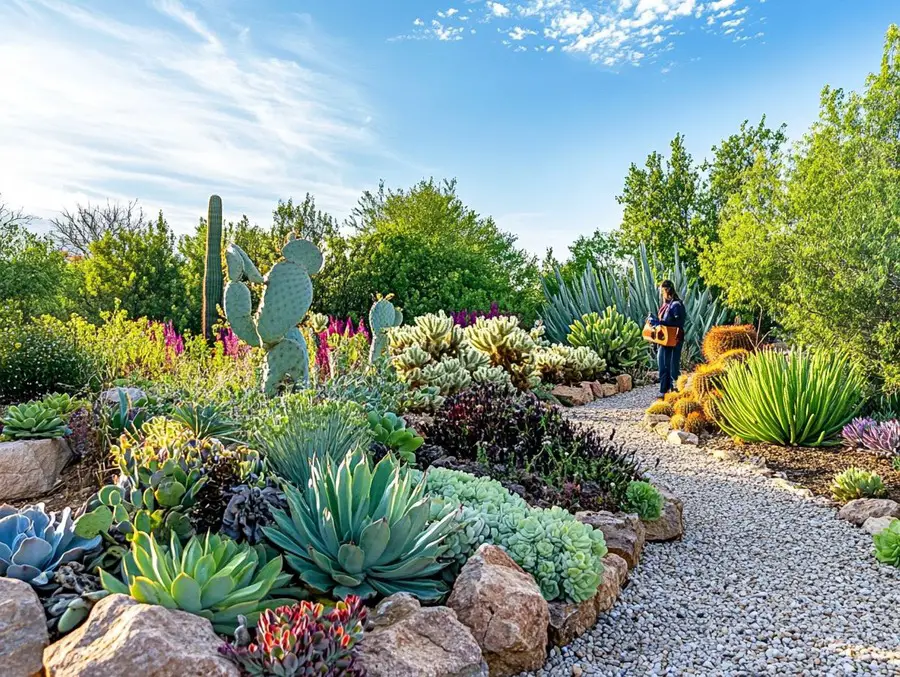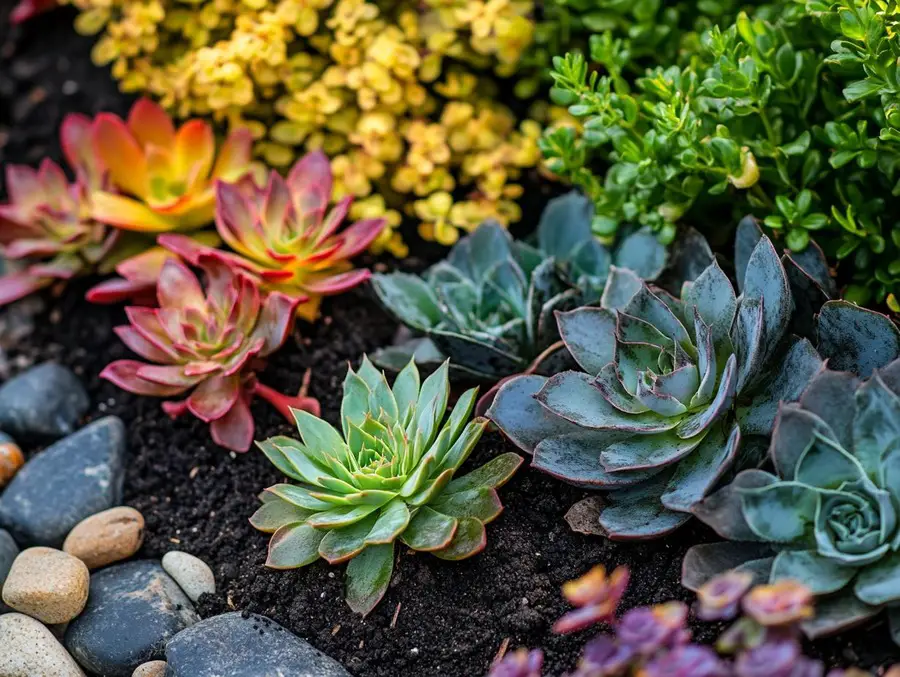We use affiliate links. If you purchase something using one of these links, we may receive compensation or commission.
Ground covers for xeriscaping are a game-changer when it comes to creating a low-maintenance, water-efficient landscape.
Without the right ground cover, soil dries out quickly, weeds take over, and your xeriscape can look unfinished.
But with drought-tolerant plants, gravel, or mulch, you can boost moisture retention, reduce upkeep, and create a vibrant, sustainable outdoor space.
Ground Covers for Xeriscaping
Key Takeaways
- Ground covers for xeriscaping help conserve water, prevent erosion, and reduce maintenance.
- Drought-tolerant plants like creeping thyme, sedum, and clover thrive with minimal irrigation.
- Gravel and mulch also provide effective ground cover while enhancing soil health.
- Choosing the right ground cover boosts sustainability and keeps your xeriscape garden looking lush year-round.
Ground Covers for Xeriscaping: Boost Beauty & Save Water
Xeriscaping is all about creating a sustainable landscape that focuses on water conservation, making it a perfect choice for those dry areas where droughts are a concern.
One great way to jump into xeriscaping is by using ground covers.
They add some serious beauty to your space and cut down on maintenance, which is always a win in your book.
This article dives into the perks of incorporating drought-tolerant plants, gravel, and mulch into your plan.
You’ll find tips on how to choose the best ground covers based on your climate and soil conditions, so your xeriscape can thrive and look fantastic.
What Are Ground Covers for Xeriscaping?
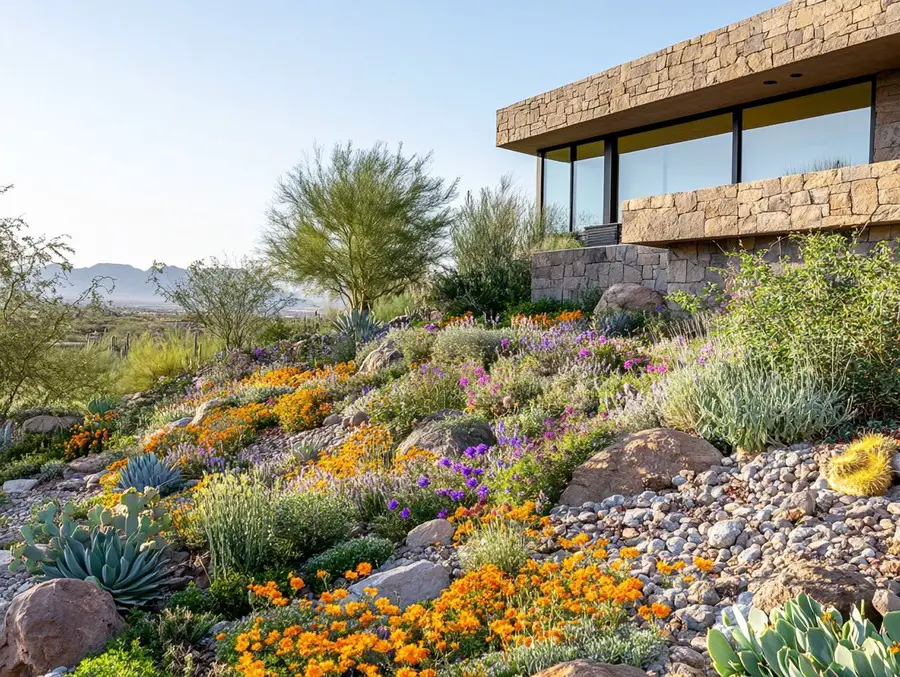
Xeriscaping is all about creating a landscape that cuts down or completely eliminates the need for extra watering, especially in dry climates.
This method uses drought-resistant plants, water-efficient landscaping techniques, and clever garden design to promote sustainability and save water.
By bringing in native plants and xerophytes, you can boost soil health and lessen your environmental impact through thoughtful planning and planting.
This approach helps control soil erosion and encourages biodiversity, so your garden can thrive even with low moisture levels.
Benefits of Using Ground Covers for Xeriscaping
Using ground covers in xeriscaping brings a ton of benefits that boost environmental health and make your garden more efficient.
These low-maintenance landscaping options aren’t just pretty to look at.
They also help improve soil health, retain moisture, and keep those pesky weeds at bay.
Ground covers are excellent at preventing erosion, creating a sustainable gardening environment that supports native species diversity and provides a cozy home for local wildlife.
They thrive in various soil types, whether you’re dealing with sandy or clay soil making them perfect for all kinds of garden designs.
They really contribute to the overall resilience of your landscape!
Water Conservation
Water conservation is one of the major perks of adding ground covers to your xeriscaping design.
By choosing drought-tolerant ground cover options, you can seriously cut down on the water your landscape needs, helping with moisture retention and improving soil health.
These eco-friendly practices can save you some cash on your water bills while boosting the sustainability of your garden.
With the right mix of hardy plants and mulch alternatives, you can create a vibrant, water-efficient landscape that thrives even in dry conditions.
Think about incorporating ground covers like creeping thyme, sedum, or stonecrop to step up your water conservation game in any landscaping project.
These resilient plants do wonders for reducing evaporation and stopping soil erosion.
To make these strategies work for you, it’s smart to group your plants based on their moisture needs and toss in a layer of organic mulch to keep that moisture locked in.
Using drip irrigation and rainwater harvesting can also support your sustainable practices, making sure your garden stays lush and healthy while conserving those precious water resources.
Reduced Maintenance
One of the best perks of using ground covers in xeriscaping is how much you can cut down on maintenance over time.
These low-maintenance landscaping options need less watering, fertilization, and weeding, making them perfect for you if you want a beautiful garden without breaking the bank.
Many ground cover plants develop deep root systems that help them withstand drought while thriving with just a bit of your TLC.
This means you can enjoy a gorgeous landscape without the back-breaking work usually tied to traditional gardens.
To really make the most of these benefits, you’ll want to choose the right types of ground covers. Think about options like:
- Creeping thyme
- Sedum
- Clover
They do well in low-maintenance settings but they also act as fantastic weed suppressors, which means even less labor for you.
When you’re getting these plants established, don’t forget to prepare the soil properly and space them out for healthy growth.
This helps keep the upkeep to a minimum later on.
And using mulch? That’s a game-changer for retaining moisture and keeping weeds at bay, making your maintenance tasks even easier.
By embracing these strategies, you can turn your garden into a vibrant, sustainable space that needs way less attention, all while looking fabulous.
Types of Ground Covers for Xeriscaping
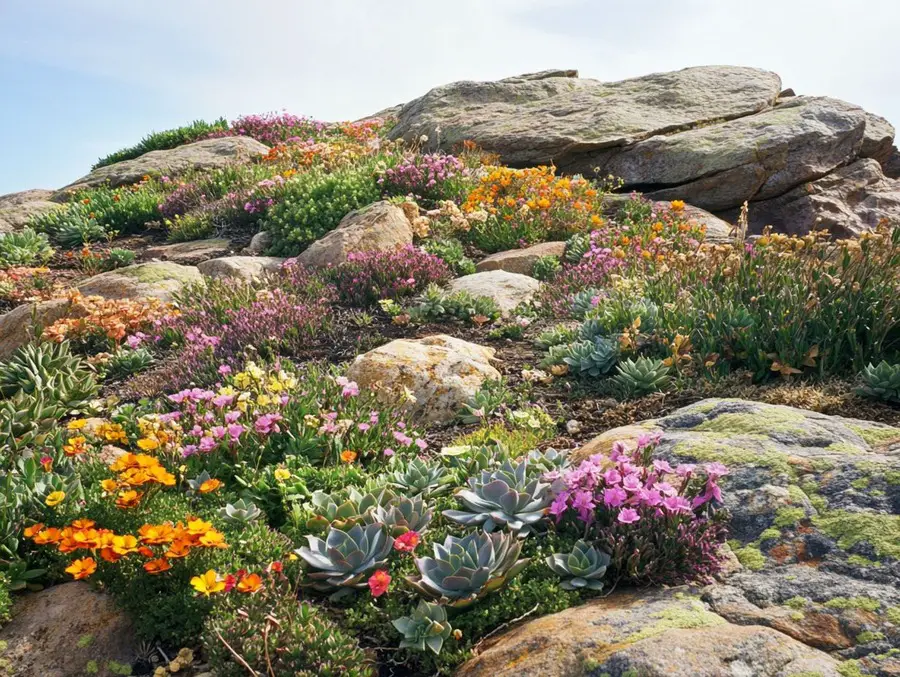
Regarding xeriscaping, you have a ton of options for ground cover types that can boost both the functionality and aesthetics of your landscape.
Drought-tolerant plants like creeping thyme and sedum are fantastic choices because they provide excellent ground cover while needing minimal water, just perfect for those eco-friendly practices you’re aiming for.
You have ornamental ground cover options that bring a splash of colors and textures, adding visual interest to any garden layout.
By choosing the right xeriscape materials, you can make sure your landscape thrives in different climates and soil types, creating a resilient and beautiful outdoor space you’ll love.
Drought-Tolerant Plants
Drought-tolerant plants are a must-have for your xeriscaping project.
They look stunning but also thrive in low-water conditions.
Think of xerophytes, like succulents and native perennial plants.
These guys have figured out how to survive on minimal moisture.
By adding a variety of drought-tolerant species to your landscape, you’re boosting its visual appeal and you’re also supporting local ecosystems and encouraging biodiversity.
This smart approach to plant selection can lead to better soil health and climate resilience, turning your garden into a wildlife haven.
Besides succulents, consider planting species like:
- Lavender
- Agave
- Desert willow
They bring vibrant colors and textures to your garden while attracting pollinators, which really enriches the ecological beauty of your space.
When you mix these plants with native species, you create a lovely blend that reflects the local environment.
For the best design, think about grouping these drought-tolerant plants based on their water needs and sun exposure.
This way, you can achieve a naturalistic look that makes maintenance a breeze.
Creating layered plantings will maximize visual interest while ensuring all the elements of your landscape support each other, embracing the principles of ecological gardening.
Gravel and Mulch
Gravel and mulch are fantastic ground cover materials for your xeriscaping project.
They bring both functional and aesthetic perks to your landscape.
They help with erosion control by stabilizing soil and improving drainage, and they also add a natural look that goes well with different planting strategies.
If you consider mulch alternatives like wood chips or bark, you’ll boost your soil health even more by retaining moisture and suppressing weeds, making your garden low-maintenance.
When you place gravel strategically, it can create attractive pathways and borders, adding a touch of visual interest to your outdoor space.
These materials are also key in managing temperature fluctuations, helping to protect your plant roots from extreme heat and cold.
Choosing the right type of gravel can reflect sunlight and act as a heat barrier, while mulch serves as a cool blanket that keeps soil moisture locked in, creating a thriving environment for drought-tolerant plants.
To make the most of these materials, pick colored or textured gravel that fits your design vision, and opt for organic mulches that break down over time to enrich the soil.
Thoughtfully integrating these elements can really transform your xeriscape into a harmonious and inviting retreat.
Factors to Consider When Choosing Ground Covers
When you’re picking the right ground covers for your xeriscaping project, you really need to think through a few key factors that can make or break your landscape.
Understanding your local climate and soil conditions is super important, as these elements determine which plants will thrive in your environment.
Finding the right balance between looks and functionality means your ground covers will make your garden more beautiful and serve essential purposes like suppressing weeds and improving the soil.
By using effective garden planning techniques, you can create a harmonious and sustainable landscape that fits your needs perfectly.
Climate and Soil Conditions
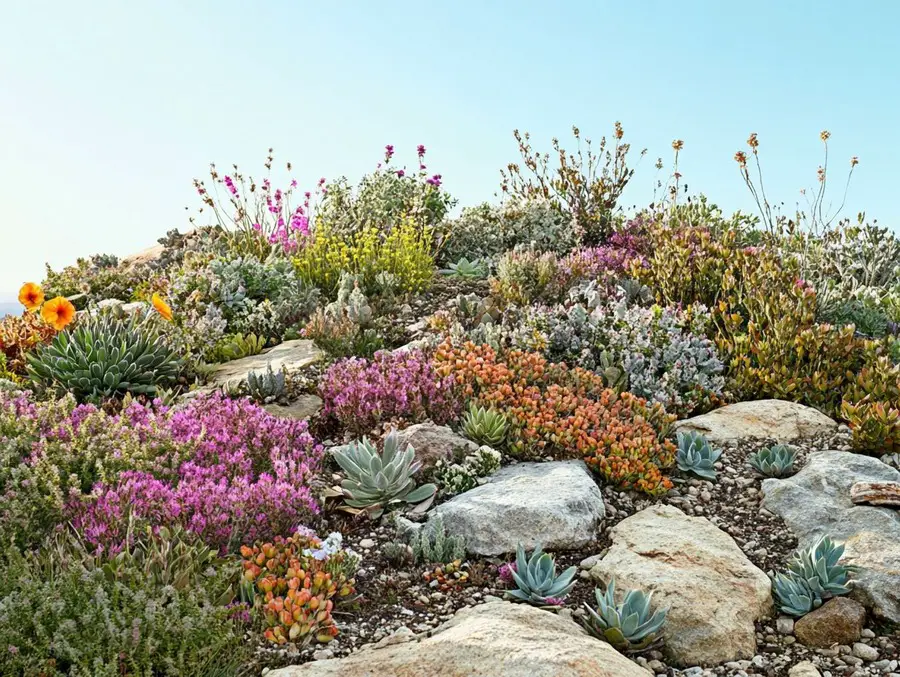
Climate and soil conditions are key players you need to think about when choosing ground covers for your xeriscaping projects.
Different soil types, like sandy or clay soil, have their quirks and require specific plants that can adapt and thrive.
Your region’s climate can seriously influence your plant choices based on temperature, rainfall, and how much sunlight those plants are going to get.
By getting to know the microclimates in your garden, those little spots with different sunlight and moisture levels, you can make smart decisions about which ground cover types will really shine in your landscape.
This know-how will lead to healthier soil and a more resilient garden overall.
Understanding that sandy soils drain quickly is crucial and they’re perfect for drought-tolerant species.
On the flip side, clay soils hold onto moisture, which can be a boon for plants that love water, but you’ll need to manage them carefully to avoid root rot.
When assessing the local climate, pay attention to seasonal temperature swings, the direction of predominant winds, and rainfall patterns.
These elements are vital for creating a solid resiliency plan.
Also, keep an eye out for microclimates in your garden, like cozy sheltered nooks or sunny spots, as they can give you great opportunities to mix up your plant selections.
That way, you’ll be cultivating a vibrant ecosystem that thrives even under different conditions.
Appearance and Functionality
When you’re choosing ground covers for xeriscaping, it’s all about finding the right balance between looking good and being functional for that perfect garden vibe.
You want your ground covers to be eye-catching, but they also need to do the heavy lifting, like suppressing weeds and stabilizing the soil.
By taking a closer look at the unique traits of different ground cover options, you can pick plants that create visual interest and also boost the ecological health of your landscape.
This thoughtful approach to selecting plants ensures your xeriscape is both stunning and effective.
To assess the aesthetic appeal of various ground covers, think about their color, texture, and growth habits.
Playing with different foliage colors can add depth, while mixing up textures can make your landscape pop.
It’s also a smart move to combine low-growing plants with taller ones to add some dimension to your garden.
And don’t forget to focus on plants that thrive in your climate.
That’s key for keeping your garden healthy overall.
Mixing in a variety of perennials and succulents amps up the beauty factor and supports biodiversity.
This way, your xeriscape will stand out and do its ecological job at the same time.
Designing a Xeriscape with Ground Covers
Designing a xeriscape with ground covers is all about taking a thoughtful approach to your landscape that focuses on water conservation and ecological sustainability.
By carefully selecting and arranging your ground covers, you can create an eye-catching outdoor space that flourishes with minimal maintenance.
Implementing effective planting strategies will boost the overall look of your garden and support soil health, moisture retention, and biodiversity.
Your xeriscape can showcase your personal style while embracing eco-friendly practices that benefit both your garden and the environment.
Tips and Ideas for Incorporating Ground Covers
Incorporating ground covers into your xeriscaping project can really take your landscape design up a notch while offering some pretty essential benefits.
Whether you want to create pathways, cover bare soil, or add some seasonal flair, there are countless creative ways to make ground covers work for you.
By choosing a variety of species that come in different colors, textures, and bloom times, you can craft a dynamic and visually appealing garden that thrives all year round.
Thoughtful integration of these plants boosts your garden’s look and helps create a sustainable and low-maintenance outdoor space.
You can strategically place ground covers under trees to create a lush and vibrant understory that helps reduce weed growth and keeps moisture from evaporating.
Think about adding flowering varieties that bloom in spring, like creeping phlox, to kick off colorful displays early in the season.
Hearty options like ajuga can keep things interesting as summer gives way to fall.
And for winter charm, evergreens like creeping thyme will ensure your landscape stays visually appealing even in the cold months.
When selecting ground covers, be sure to assess your local climate conditions and soil types to ensure that your chosen plants will thrive and blend harmoniously into your landscape.
Frequently Asked Questions
What are the benefits of using ground covers for xeriscaping?
Ground covers can help to prevent erosion, reduce water usage, and provide a natural habitat for beneficial insects and birds.
They also add visual interest and can help to suppress weed growth.
Which types of ground covers are suitable for xeriscaping?
Drought-resistant plants such as succulents, ornamental grasses, and native wildflowers are great options for xeriscaping.
Some other popular choices include creeping thyme, ice plant, and sedum.
How do I choose the right ground cover for my xeriscape garden?
Consider the sunlight and soil conditions of your garden, as well as the desired height and spread of the ground cover.
It is also important to select plants that are well-suited to your climate and can tolerate drought conditions.
Can I use mulch as a ground cover for xeriscaping?
Yes, organic mulch such as wood chips or compost can be used as a ground cover in xeriscaping. It helps to retain moisture in the soil and suppress weed growth.
However, be sure to use a layer thick enough to prevent evaporation and add more as needed.
How do I maintain ground covers in a xeriscape garden?
Ground covers in xeriscaping require minimal maintenance once established.
Regular weeding, watering during dry spells, and light pruning to remove dead foliage are typically all that is needed.
Avoid over-fertilizing, as this can cause rapid and excessive growth.
Are there any ground covers for xeriscaping that provide additional benefits?
Yes, some ground covers have additional benefits such as attracting pollinators, providing ground cover for erosion control, and even producing edible berries or fruits.
Do some research and choose a ground cover that fits your specific needs and goals for your xeriscape garden.
Best Plants for Xeriscape Gardens: Hardy & Beautiful
Xeriscape Garden Styles: Easy Low-Maintenance Options
Xeriscape Gardening Techniques: Easy Low-Water Tips
Xeriscape Garden Design & Layout: Easy Water-Wise Beauty
What is xeriscaping? A beginner’s guide to drought-tolerant landscaping – Colorado State University
Related Content
Visit my Amazon Influencer Page for videos and gardening products Grow Your Own Garden

